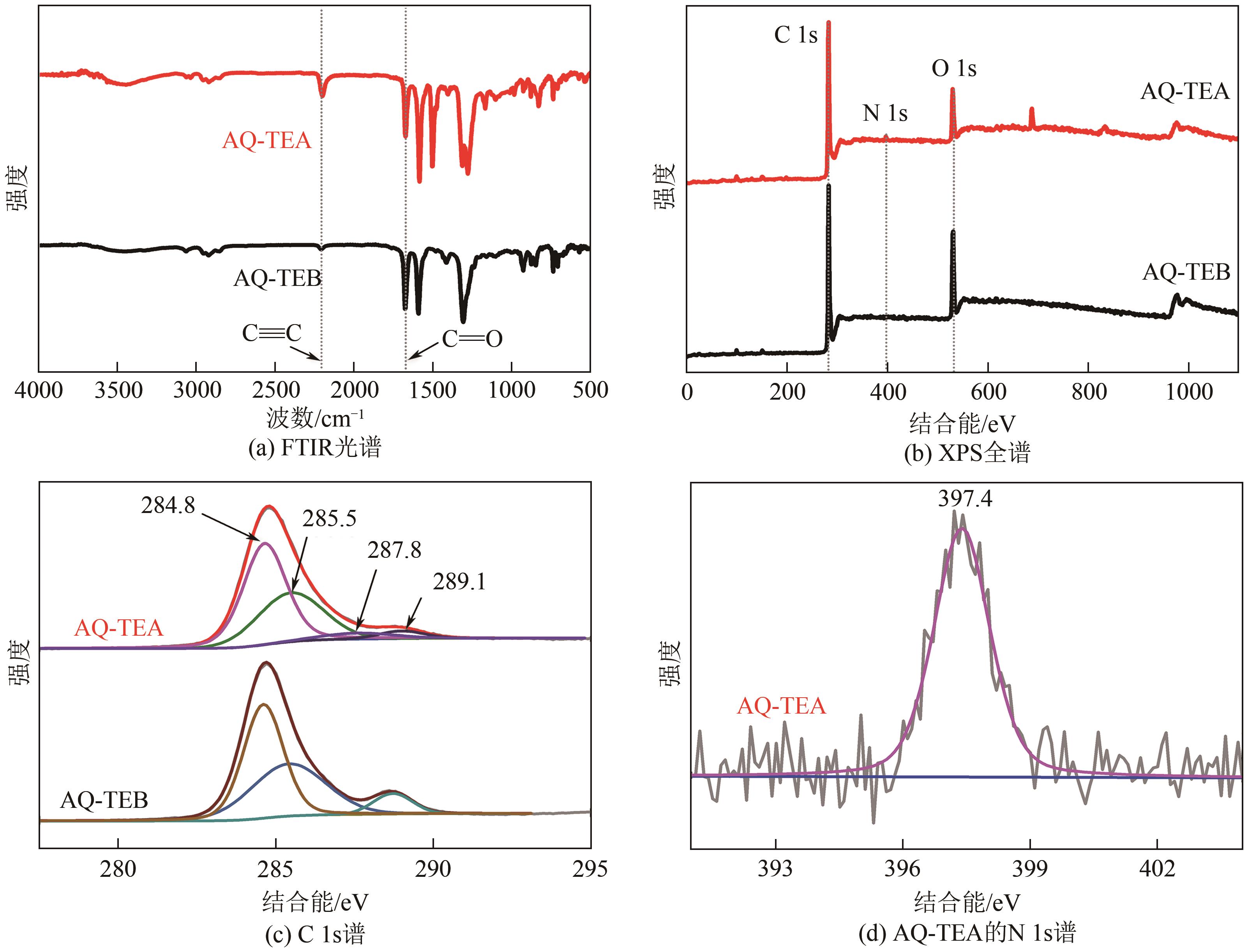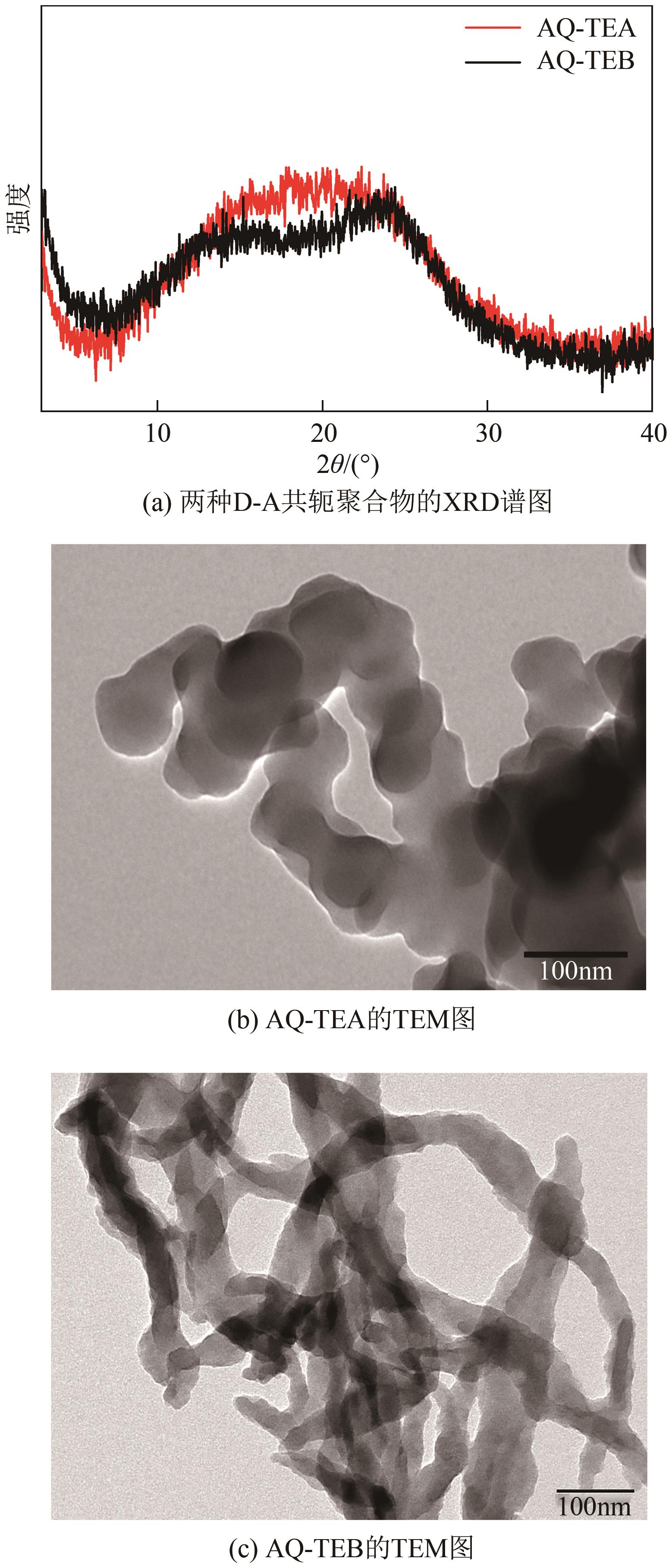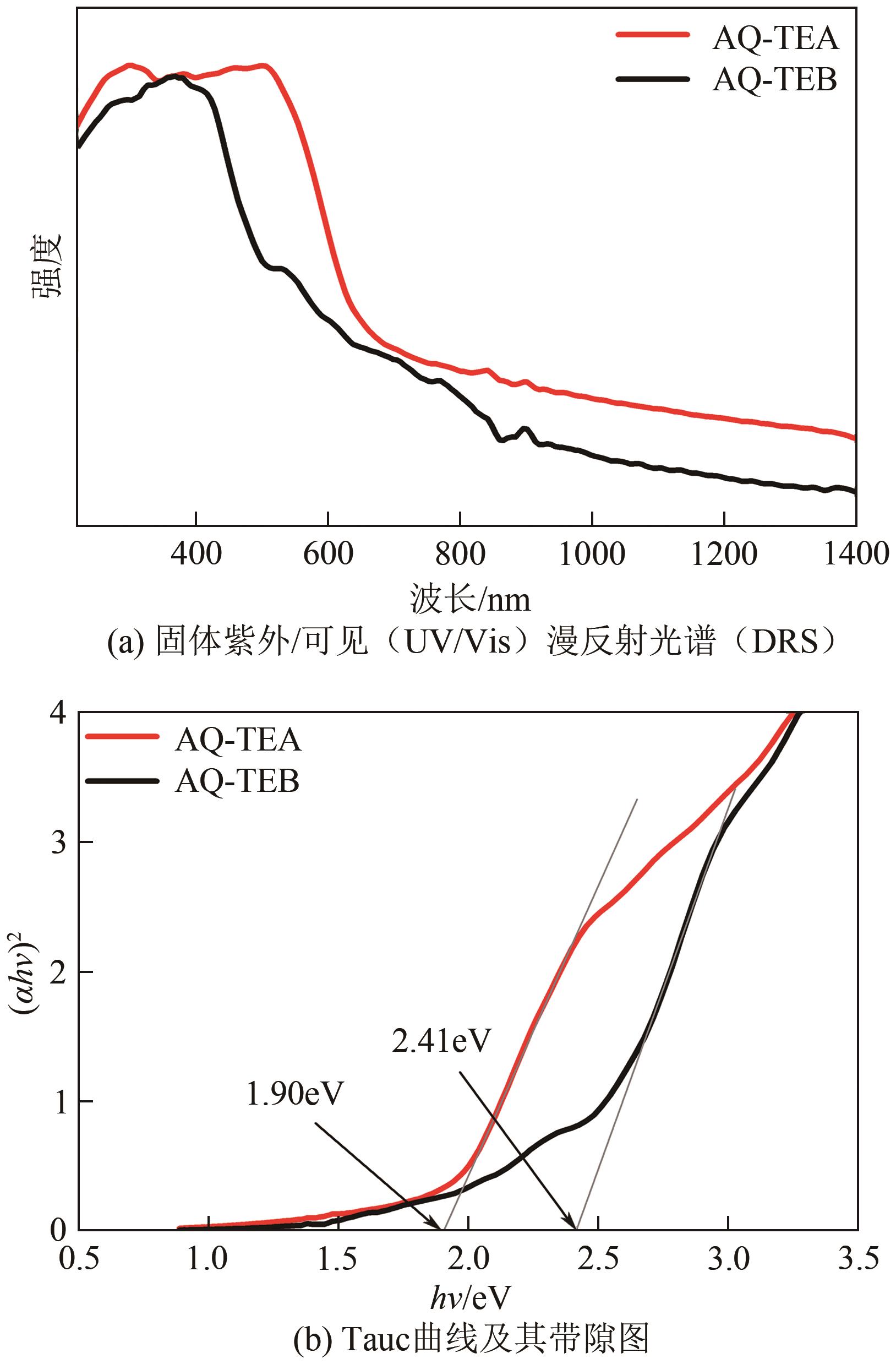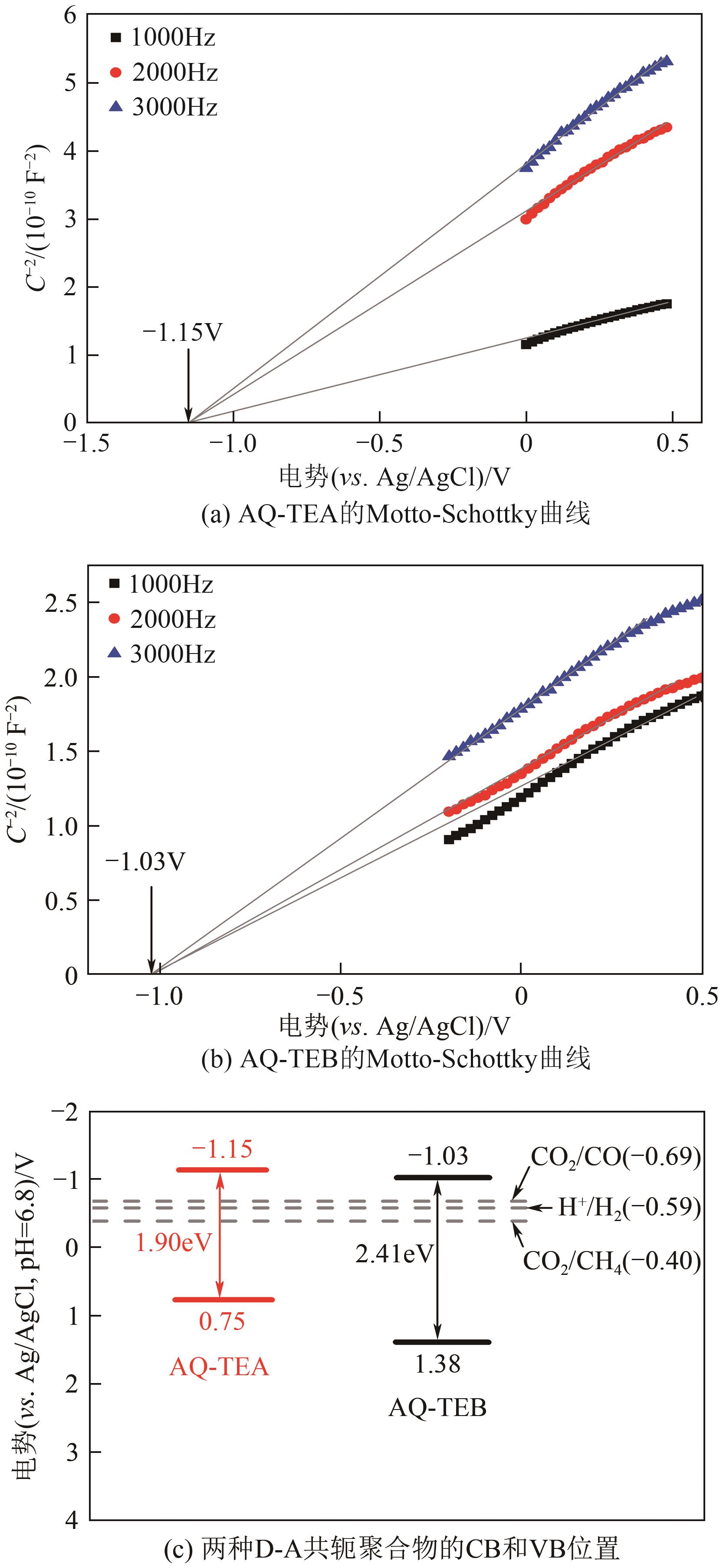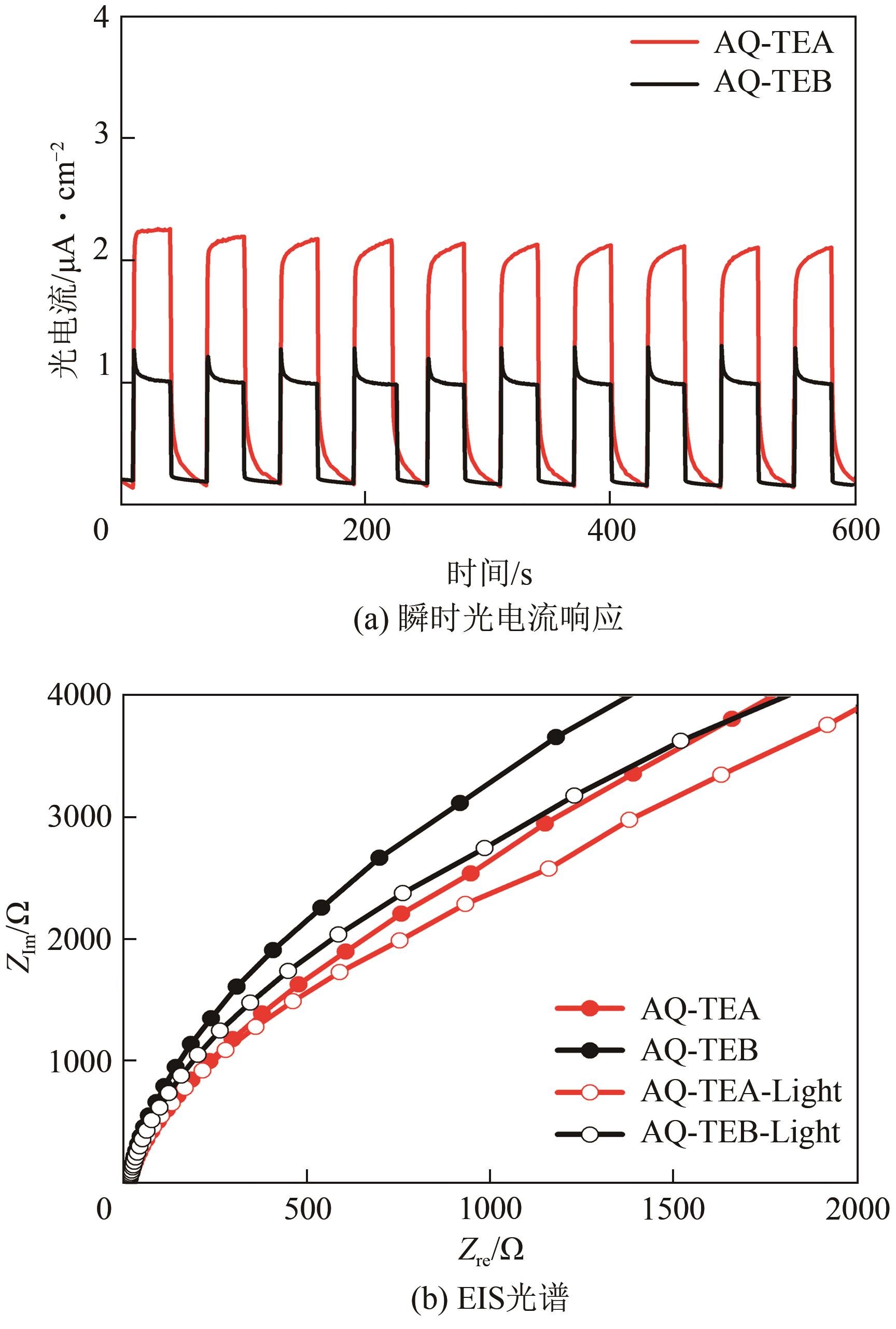化工进展 ›› 2024, Vol. 43 ›› Issue (1): 292-301.DOI: 10.16085/j.issn.1000-6613.2023-1463
• 专栏:化工过程强化 • 上一篇
D-A共轭聚合强化光电性能及光催化CO2转化
于笑笑1( ), 巢艳红1, 刘海燕1, 朱文帅2,3(
), 巢艳红1, 刘海燕1, 朱文帅2,3( ), 刘植昌2
), 刘植昌2
- 1.中国石油大学(北京)理学院,北京 102249
2.中国石油大学(北京)化学工程与环境学院,北京 102249
3.江苏大学化学化工学院, 江苏 镇江 212013
-
收稿日期:2023-08-21修回日期:2023-11-01出版日期:2024-01-20发布日期:2024-02-05 -
通讯作者:朱文帅 -
作者简介:于笑笑(1991—),女,博士,副教授,研究方向为CO2催化转化。E-mail:xiaoxiaoyu@cup.edu.cn。 -
基金资助:国家自然科学基金(22178154);中国石油大学(北京)科学基金(2462023QNXZ009);重质油全国重点实验室自主研究项目(2023-12);海南省水环境污染治理与资源化重点实验室(SHJKFKT202306)
Enhanced photoelectric properties and photocatalytic CO2 conversion by D-A conjugated polymerization
YU Xiaoxiao1( ), CHAO Yanhong1, LIU Haiyan1, ZHU Wenshuai2,3(
), CHAO Yanhong1, LIU Haiyan1, ZHU Wenshuai2,3( ), LIU Zhichang2
), LIU Zhichang2
- 1.College of Science, China University of Petroleum (Beijing), Beijing 102249, China
2.College of Chemical Engineering and Environment, China University of Petroleum (Beijing), Beijing 102249, China
3.School of Chemistry and Chemical Engineering, Jiangsu University, Zhenjiang 212013, Jiangsu, China
-
Received:2023-08-21Revised:2023-11-01Online:2024-01-20Published:2024-02-05 -
Contact:ZHU Wenshuai
摘要:
2,6-二溴蒽醌(2,6-dibromoanthraquinone,AQ)分别与三(4-乙炔苯基)胺(tris(4-ethynylphenyl)amine,TEA)和1,3,5-三乙炔基苯(1,3,5-triethynylbenzene,TEB),通过Sonogashira偶联反应制备得到两种蒽醌功能化的给体-受体(D-A)共轭聚合物催化剂(AQ-TEA和AQ-TEB)。采用FTIR、XPS、XRD和TEM 对其化学结构和形貌进行了表征。通过固体紫外/可见漫反射光谱、稳态荧光光谱、时间分辨荧光光谱和电化学表征探究了两种催化材料的光学和电学性能。结果表明,三(4-乙炔苯基)胺与2,6-二溴蒽醌构筑的AQ-TEA表现出更强的可见光吸收和电荷转移性能。研究了两种光催化剂在H2O环境下光还原CO2的催化性能。特别是AQ-TEA表现出更好的光催化性能,其CO的生成速率为392μmol/(g·h),是AQ-TEB的1.8倍。基于实验和理论计算的结果,推测共轭聚合物中强的分子内电荷转移(intramolecular charge transfer,ICT)可促进其光吸收、光电转换和光催化效率的提升。本研究为设计和制备高效的光催化活性共轭聚合物催化剂提供了新的思路。
中图分类号:
引用本文
于笑笑, 巢艳红, 刘海燕, 朱文帅, 刘植昌. D-A共轭聚合强化光电性能及光催化CO2转化[J]. 化工进展, 2024, 43(1): 292-301.
YU Xiaoxiao, CHAO Yanhong, LIU Haiyan, ZHU Wenshuai, LIU Zhichang. Enhanced photoelectric properties and photocatalytic CO2 conversion by D-A conjugated polymerization[J]. Chemical Industry and Engineering Progress, 2024, 43(1): 292-301.
| 催化剂 | 波长/nm | 添加剂 | 产CO效率/ μmol·g-1·h-1 | 参考文献 |
|---|---|---|---|---|
| 40NU@FNBZ | >420 | H2O | 18.78 | [ |
| TAPBB-COF | >200, 60℃ | H2O | 24.6 | [ |
| CB-COP-mpd | >420 | H2O | 191.46 | [ |
| P3HT/TiO2/RePc226 | >500 | H2O,16.7% TEOA(体积分数) | 138.9 | [ |
| CoPor-DBBP | >400 | H2O∶MeCN∶TEA= 4∶1∶2 | 286.7 | [ |
| AQ-TEA | >300 | H2O,16.7% TEOA(体积分数) | 392 | 本工作 |
表1 光催化CO2还原制CO催化剂
| 催化剂 | 波长/nm | 添加剂 | 产CO效率/ μmol·g-1·h-1 | 参考文献 |
|---|---|---|---|---|
| 40NU@FNBZ | >420 | H2O | 18.78 | [ |
| TAPBB-COF | >200, 60℃ | H2O | 24.6 | [ |
| CB-COP-mpd | >420 | H2O | 191.46 | [ |
| P3HT/TiO2/RePc226 | >500 | H2O,16.7% TEOA(体积分数) | 138.9 | [ |
| CoPor-DBBP | >400 | H2O∶MeCN∶TEA= 4∶1∶2 | 286.7 | [ |
| AQ-TEA | >300 | H2O,16.7% TEOA(体积分数) | 392 | 本工作 |
| 1 | LI Xin, YU Jiaguo, Jaroniec Mietek, et al. Cocatalysts for selective photoreduction of CO2 into solar fuels[J]. Chemical Reviews, 2019, 119(6): 3962-4179. |
| 2 | CHU Steven. Carbon capture and sequestration[J]. Science, 2009, 325(5948): 1599. |
| 3 | WANG Zhoujun, SONG Hui, LIU Huimin, et al. Coupling of solar energy and thermal energy for carbon dioxide reduction: Status and prospects[J]. Angewandte Chemie International Edition, 2020, 59(21): 8016-8035. |
| 4 | WANG Changli, LV Zunhang, YANG Wenxiu, et al. A rational design of functional porous frameworks for electrocatalytic CO2 reduction reaction[J]. Chemical Society Reviews, 2023,52(4): 1382-1427. |
| 5 | HU Canyu, CHEN Xing, Jingxiang LOW, et al. Near-infrared-featured broadband CO2 reduction with water to hydrocarbons by surface plasmon[J]. Nature Communications, 2023, 14: 221. |
| 6 | ADACHI Taiki, KITAZUMI Yuki, SHIRAI Osamu, et al. Recent progress in applications of enzymatic bioelectrocatalysis[J]. Catalysts, 2020, 10(12): 1413. |
| 7 | GERARDO Grasso, DANIELA Zane, ROBERTO Dragone. Microbial nanotechnology: Challenges and prospects for green biocatalytic synthesis of nanoscale materials for sensoristic and biomedical applications[J]. Nanomaterials, 2019, 10(1): 11. |
| 8 | YUAN Lan, QI Mingyu, TANG Zirong, et al. Coupling strategy for CO2 valorization integrated with organic synthesis by heterogeneous photocatalysis[J]. Angewandte Chemie International Edition, 2021, 60(39): 21150-21172. |
| 9 | 霍景沛, 林冲, 陈桂煌. 光催化二氧化碳还原催化体系研究进展[J]. 化学推进剂与高分子材料, 2020, 18(3): 8-14. |
| HUO Jingpei, LIN Chong, CHEN Guihuang. Research progress in photocatalytic reduction catalyst system of carbon dioxide[J]. Chemical Propellants & Polymeric Materials, 2020, 18(3): 8-14. | |
| 10 | GUO Zhenguo, CHEN Gui, COMETTO Claudio, et al. Selectivity control of CO versus HCOO-production in the visible-light-driven catalytic reduction of CO2 with two cooperative metal sites[J]. Nature Catalysis, 2019, 2(9): 801-808. |
| 11 | TAKEDA Hiroyuki, COMETTO Claudio, ISHITANI Osamu, et al. Electrons, photons, protons and earth-abundant metal complexes for molecular catalysis of CO2 reduction[J]. ACS Catalysis, 2017, 7(1): 70-88. |
| 12 | PARASTAEV Alexander, MURAVEV Valery, OSTA Elisabet Huertas, et al. Breaking structure sensitivity in CO2 hydrogenation by tuning metal-oxide interfaces in supported cobalt nanoparticles[J]. Nature Catalysis, 2022, 5(11): 1051-1060. |
| 13 | WANG Ting, SUN Fuli, LIU Shoujie, et al. Dioxygen-enhanced CO2 photoreduction on TiO2 supported Cu single-atom sites[J]. Applied Catalysis B: Environmental, 2023, 325: 122339. |
| 14 | WU Dongxue, LIANG Qian, SI Honglin, et al. Self-assembly of a heterogeneous microreactor with carbon dots embedded in Ti-MOF derived ZnIn2S4/TiO2 microcapsules for efficient CO2 photoreduction[J]. Journal of Materials Chemistry A, 2022, 10(46): 24519-24528. |
| 15 | 王英杰, 董辰, 谢亚勃, 等. MOF基材料绿色催化CO2还原研究进展[J]. 北京工业大学学报, 2022, 48(3): 261-272, 305. |
| WANG Yingjie, DONG Chen, XIE Yabo, et al. Research progress of CO2 reduction catalyzed by MOF-based materials[J]. Journal of Beijing University of Technology, 2022, 48(3): 261-272, 305. | |
| 16 | DAI Chunhui, LIU Bin. Conjugated polymers for visible-light-driven photocatalysis[J]. Energy & Environmental Science, 2020, 13(1): 24-52. |
| 17 | HUANG Kuan, ZHANG Jia Yin, LIU Fujian, et al. Synthesis of porous polymeric catalysts for the conversion of carbon dioxide[J]. ACS Catalysis, 2018, 8(10): 9079-9102. |
| 18 | SPRICK Reiner Sebastian, JIANG Jiaxing, BONILLO Baltasar, et al. Tunable organic photocatalysts for visible-light-driven hydrogen evolution[J]. Journal of the American Chemical Society, 2015, 137(9): 3265-3270. |
| 19 | YANG Sizhuo, HU Wenhui, ZHANG Xin, et al. 2D covalent organic frameworks as intrinsic photocatalysts for visible light-driven CO2 reduction[J]. Journal of the American Chemical Society, 2018, 140(44): 14614-14618. |
| 20 | 刘雨菲, 张蜜, 路猛, 等. 共价有机框架材料在光催化CO2还原中的应用[J]. 化学进展, 2023, 35(3): 349-359. |
| LIU Yvfei, ZHANG Mi, LU Meng, et al. Covalent organic frameworks for photocatalytic CO2 reduction[J]. Progress in Chemistry, 2023, 35(3): 349-359. | |
| 21 | WANG Shengyao, Xiao HAI, DING Xing, et al. Intermolecular cascaded π-conjugation channels for electron delivery powering CO2 photoreduction[J]. Nature Communications, 2020, 11: 1149. |
| 22 | Surya DAS, HAZRA CHOWDHURY Ipsita, HAZRA CHOWDHURY Arpita, et al. Metal-free covalent organic framework for facile production of solar fuel via CO2 reduction[J]. Industrial & Engineering Chemistry Research, 2022, 61(46): 17044-17056. |
| 23 | LEENAERS Pieter J, MAUFORT Arthur J L A, WIENK Martijn M, et al. Impact of π-conjugated linkers on the effective exciton binding energy of diketopyrrolopyrrole-dithienopyrrole copolymers[J]. The Journal of Physical Chemistry C, 2020, 124(50): 27403-27412. |
| 24 | YU Xiaoxiao, TIAN Shuyao, ZHANG Fengtao, et al. Tailoring the exciton binding energy of 2D conjugated polymers for powering metal-free CO2 photoreduction[J]. ACS Sustainable Chemistry & Engineering, 2022, 10(49): 16182-16188. |
| 25 | LAN Zhian, ZHANG Guigang, CHEN Xiong, et al. Reducing the exciton binding energy of donor-acceptor-based conjugated polymers to promote charge-induced reactions[J]. Angewandte Chemie (International Ed in English), 2019, 58(30): 10236-10240. |
| 26 | CUI Lin, YU Shilong, GAO Wenqiang, et al. Tetraphenylenthene-based conjugated microporous polymer for aggregation-induced electrochemiluminescence[J]. ACS Applied Materials & Interfaces, 2020, 12(7): 7966-7973. |
| 27 | YU Fengtao, ZHU Zhiqiang, LI Chuangye, et al. A redox-active perylene-anthraquinone donor-acceptor conjugated microporous polymer with an unusual electron delocalization channel for photocatalytic reduction of uranium (Ⅵ) in strongly acidic solution[J]. Applied Catalysis B: Environmental, 2022, 314: 121467. |
| 28 | LUO Lianwei, MA Wenyan, DONG Peihua, et al. Synthetic control of electronic property and porosity in anthraquinone-based conjugated polymer cathodes for high-rate and long-cycle-life Na-organic batteries[J]. ACS Nano, 2022, 16(9): 14590-14599. |
| 29 | QIAN Yunyang, LI Dandan, HAN Yulan, et al. Photocatalytic molecular oxygen activation by regulating excitonic effects in covalent organic frameworks[J]. Journal of the American Chemical Society, 2020, 142(49): 20763-20771. |
| 30 | LI Xiaojiao, SUN Hong-Bin, SUN Xudong. Polysulfone grafted with anthraquinone-hydroanthraquinone redox as a flexible membrane electrode for aqueous batteries[J]. Polymer, 2021, 234: 124245. |
| 31 | KIM Wonbin, AHMAD Zubair, LEE Hong-Joon, et al. Electrochemical properties of anthraquinone-containing polymer nanocomposite by nano-level molecular ordering[J]. Polymer Chemistry, 2021, 12(42): 6154-6160. |
| 32 | RUIZ-MUELLE Ana Belén, Rafael CONTRERAS-CÁCERES, Pascual OÑA-BURGOS, et al. Polyacrylic acid polymer brushes as substrates for the incorporation of anthraquinone derivatives. Unprecedented application of decorated polymer brushes on organocatalysis[J]. Applied Surface Science, 2018, 428: 566-578. |
| 33 | GUO Shien, XIAO Yuting, JIANG Baojiang. Encapsulation of Pd nanoparticles in covalent triazine frameworks for enhanced photocatalytic CO2 conversion[J]. ACS Sustainable Chemistry & Engineering, 2021, 9(37): 12646-12654. |
| 34 | Kyung-Lyul BAE, KIM Jinmo, Chan Kyu LIM, et al. Colloidal zinc oxide-copper(Ⅰ) oxide nanocatalysts for selective aqueous photocatalytic carbon dioxide conversion into methane[J]. Nature Communications, 2017, 8: 1156. |
| 35 | YU Xiaoxiao, GONG Ke, TIAN Shuyao, et al. A hydrophilic fully conjugated covalent organic framework for photocatalytic CO2 reduction to CO nearly 100% using pure water[J]. Journal of Materials Chemistry A, 2023, 11(11): 5627-5635. |
| 36 | GUO Liping, NIU Yingli, XU Haitao, et al. Engineering heteroatoms with atomic precision in donor-acceptor covalent triazine frameworks to boost photocatalytic hydrogen production[J]. Journal of Materials Chemistry A, 2018, 6(40): 19775-19781. |
| 37 | WANG Congyong, ZHANG Zhicheng, ZHU Yating, et al. 2D covalent organic frameworks: From synthetic strategies to advanced optical-electrical-magnetic functionalities[J]. Advanced Materials, 2022, 34(17): e2102290. |
| 38 | ZHENG Bing, QI Feng, ZHANG Yu, et al. Over 14% efficiency single-junction organic solar cells enabled by reasonable conformation modulating in naphtho[2, 3-b: 6, 7-b']difuran based polymer[J]. Advanced Energy Materials, 2021, 11(13): 2003954. |
| 39 | BARMAN Soumitra, SINGH Ashish, RAHIMI Faruk Ahamed, et al. Metal-free catalysis: A redox-active donor-acceptor conjugated microporous polymer for selective visible-light-driven CO2 reduction to CH4 [J]. Journal of the American Chemical Society, 2021, 143(39): 16284-16292. |
| 40 | CHEN Bo, CHEN Wanru, WANG Miao, et al. Unravelling the multiple synergies in MOF/CMP supramolecular heterojunction for enhanced artificial photosynthesis[J]. Advanced Materials Interfaces, 2023, 10(6): 2201971. |
| 41 | WANG Lujie, WANG Ruilei, ZHANG Xiao, et al. Improved photoreduction of CO2 with water by tuning the valence band of covalent organic frameworks[J]. ChemSusChem, 2020, 13(11): 2973-2980. |
| 42 | YE Wenqiang, WANG Yuepeng, JI Guipeng, et al. Carbazolic conjugated organic polymers for visible-light-driven CO2Photoreduction with H2O to CO with high efficiency and selectivity[J]. ChemSusChem, 2022, 15(16): e202200759. |
| 43 | CHOE Min Su, CHOI Sunghan, LEE Hyun Seok, et al. Sustainable carbon dioxide reduction of the P3HT polymer-sensitized TiO2/Re(Ⅰ) photocatalyst[J]. ACS Applied Materials & Interfaces, 2022, 14(45): 50718-50730. |
| 44 | YU Zhen, XIAO Yuting, GUO Shien, et al. Visible light-driven selective reduction of CO2 by acetylene-bridged cobalt porphyrin conjugated polymers[J]. ChemSusChem, 2022, 15(12): e202200424. |
| [1] | 王达锐, 孙洪敏, 王一棪, 唐智谋, 李芮, 范雪研, 杨为民. 分子筛催化反应过程高效化的技术进展[J]. 化工进展, 2024, 43(1): 1-18. |
| [2] | 罗芬, 杨晓琪, 段方麟, 李小江, 吴亮, 徐铜文. 双极膜研究进展及应用展望[J]. 化工进展, 2024, 43(1): 145-163. |
| [3] | 盖宏伟, 张辰君, 屈晶莹, 孙怀禄, 脱永笑, 王斌, 金旭, 张茜, 冯翔, CHEN De. 有机液体储氢技术催化脱氢过程强化研究进展[J]. 化工进展, 2024, 43(1): 164-185. |
| [4] | 张家昊, 李盈盈, 徐彦琳, 尹佳滨, 张吉松. 微反应器中连续还原胺化反应的研究进展[J]. 化工进展, 2024, 43(1): 186-197. |
| [5] | 衡霖宇, 邓卓然, 程道建, 魏彬, 赵利强. 高通量合成装置强化金属催化剂制备过程的研究进展[J]. 化工进展, 2024, 43(1): 246-259. |
| [6] | 王一棪, 王达锐, 沈震浩, 何俊琳, 孙洪敏, 杨为民. 全结晶MCM-22分子筛催化剂的制备及其催化性能[J]. 化工进展, 2024, 43(1): 285-291. |
| [7] | 杨寒月, 孔令真, 陈家庆, 孙欢, 宋家恺, 王思诚, 孔标. 微气泡型下向流管式气液接触器脱碳性能[J]. 化工进展, 2023, 42(S1): 197-204. |
| [8] | 王胜岩, 邓帅, 赵睿恺. 变电吸附二氧化碳捕集技术研究进展[J]. 化工进展, 2023, 42(S1): 233-245. |
| [9] | 张明焱, 刘燕, 张雪婷, 刘亚科, 李从举, 张秀玲. 非贵金属双功能催化剂在锌空气电池研究进展[J]. 化工进展, 2023, 42(S1): 276-286. |
| [10] | 时永兴, 林刚, 孙晓航, 蒋韦庚, 乔大伟, 颜彬航. 二氧化碳加氢制甲醇过程中铜基催化剂活性位点研究进展[J]. 化工进展, 2023, 42(S1): 287-298. |
| [11] | 谢璐垚, 陈崧哲, 王来军, 张平. 用于SO2去极化电解制氢的铂基催化剂[J]. 化工进展, 2023, 42(S1): 299-309. |
| [12] | 杨霞珍, 彭伊凡, 刘化章, 霍超. 熔铁催化剂活性相的调控及其费托反应性能[J]. 化工进展, 2023, 42(S1): 310-318. |
| [13] | 郑谦, 官修帅, 靳山彪, 张长明, 张小超. 铈锆固溶体Ce0.25Zr0.75O2光热协同催化CO2与甲醇合成DMC[J]. 化工进展, 2023, 42(S1): 319-327. |
| [14] | 戴欢涛, 曹苓玉, 游新秀, 徐浩亮, 汪涛, 项玮, 张学杨. 木质素浸渍柚子皮生物炭吸附CO2特性[J]. 化工进展, 2023, 42(S1): 356-363. |
| [15] | 王乐乐, 杨万荣, 姚燕, 刘涛, 何川, 刘逍, 苏胜, 孔凡海, 朱仓海, 向军. SCR脱硝催化剂掺废特性及性能影响[J]. 化工进展, 2023, 42(S1): 489-497. |
| 阅读次数 | ||||||
|
全文 |
|
|||||
|
摘要 |
|
|||||

